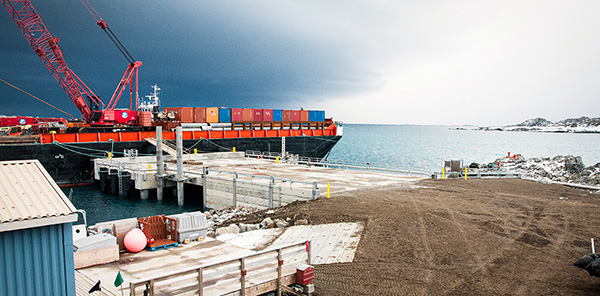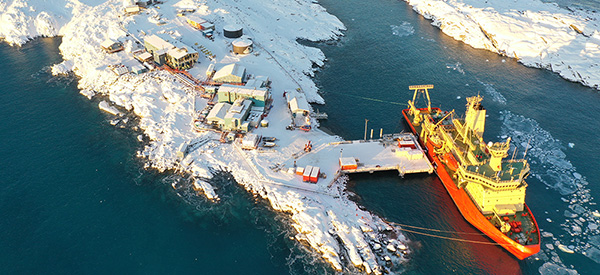Construction of New Pier at Palmer Station Now Complete
Construction Completed in Just Four Months, Ahead of Schedule
July 6, 2022
Construction of the new pier at Palmer Station was completed at the end of April, the first major milestone in modernizing the research station and expanding its capacity for scientific research.
Construction was completed in just four months and wrapped up slightly ahead of schedule, despite delays in transporting materials and construction crews from the continental United States to Palmer Station.
The new pier is more than three times larger than the old pier and extends into deeper water. This allows larger ships to dock at Palmer, including the Nathaniel B. Palmer and the proposed Antarctic Research Vessel (ARV) currently in development. The new pier also gives station staff an additional 5,000 square feet of workspace for handling cargo and supplies, which vastly improves the flow of materials on and off the station.

The barge Martin Ray docked at the newly-completed pier at Palmer Station. The barge will carry the remaining construction materials and equipment back to the continental United States.
The new pier consists of a concrete deck supported by steel piles as well as an energy-absorbing fender system. Much of the structure was prefabricated in Seattle and shipped to Antarctica aboard a 400-foot-long barge. The barge arrived at Palmer Station on January 4, 2022, carrying more than 6,000 tons of equipment and supplies.
Construction was completed in about 16 weeks and the barge departed Palmer on April 24. The Laurence M. Gould was the first ship to dock at the new structure, reaching Palmer in early May. The United States' larger research vessel, the Nathaniel B. Palmer, docked at Palmer Station for the first time ever on May 29, thanks to the new pier.
Palmer is the smallest of the three U.S. research stations in Antarctica and is only accessible by ship, so its pier is vital to the safe transport of cargo and personnel to and from the station.
The new pier's modern design increases the station's ability to support scientific research throughout the Antarctic Peninsula region. A larger, more reliable platform to stage materials and equipment is necessary for the advancement of Palmer-based science in fields such as marine biology, oceanography, and climate change. The new pier is also the first critical step in the eventual redevelopment of the entire 50-year-old station, which will allow Palmer to be a hub for science in the region for decades to come.
View a timelapse video of the pier construction process below.


